The photos of Lien Tri Pagoda that we see now are probably the last ones we will ever see of it. Comes September 30, and the place where Lien Tri Pagoda used to be will become an uneven, empty and dilapidated dirt lot. Open your mind’s eyes and you would see strewn everywhere on the lot broken pieces from statues of the Lord Buddha and shards from smashed cremation jars. Look harder and you might yet see among the swirling dirt devils forlorn and ashen ghosts straggling around searching for another eternal resting place. No bells will toll for these souls. The bells of Lien Tri Pagoda would have been silenced forever. And if you listen long and hard enough with your mind’s ears, you might yet hear the hellish cacophony that scientific dialectic materialism, the belief in the primacy of materialism over consciousness, and the never ending, greedy and merciless struggles for money and power conspire to bring forth.
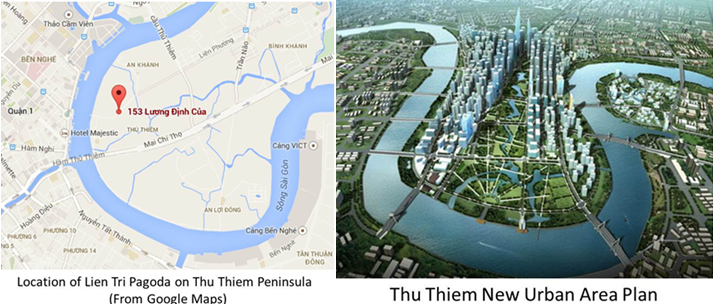
Defend The Defenders | Oct 1, 2014
Translation by [rollinglinks]Huynh Thuc Vy [/rollinglinks]
Tell the World
The Government of Vietnam (GVN) in Hanoi recently renews its campaign to suppress human rights and take down religious establishments not currently under its management. This campaign has received a great deal of attention – mostly extreme outrage and indignation – from the international community and also public opinion both inside and outside of the country.
A key target of the GVN in the above campaign is Lien Tri Pagoda. The GVN is attempting to take down this religious establishment using technique called “implementation of administrative coercive measures.” In this technique, the GVN in Hanoi makes the lowest level local government collect the information needed to prosecute the targeted establishment while being monitored by international organizations. Through this technique, the GVN hopes to minimize the adverse risk that during negotiations or discussions with the GVN, Western officials will accuse it of oppressing religious groups or committing human rights violations to strengthen their bargaining position.
This short article reports on the current status of Lien Tri Pagoda and aims to inform and alert public opinion about current and flagrant violations of human rights and religious freedom perpetrated by the GVN.
Lien Tri Pagoda is located on Thu Thiem peninsula at 153 Luong Dinh Cua Street, District 2, Saigon. The Thu Thiem peninsula is a quasi-circular area about 7 square kilometers in area (1,726 acres). The peninsula is carved from the banks of the Saigon River as it meanders its way to the South China Sea. From the air, one can see that the southern tip of the peninsula points to the center of the city. Due to its location, the Thu Thiem peninsula has been selected to be site of an ultra-modern and ambitious upscale housing and financial center development project dubbed the New Thu Thiem Urban Area. For this project to become a reality, lots of people will have to be displaced, and home and established building razed.The photos below show the location of Lien Tri Pagoda and a conceptual view of the future New Thu Thiem Urban Area.
Lien Tri Pagoda was built around the 1956-1957 timeframe thanks to the contributions from local Buddhists. The 800 square meters (8,611 square feet) pagoda was originally dedicated to Venerable Thich Thien Hoa, the late Abbot of the Institute for The Propagation of The Faith of the United Buddhist Church of Vietnam. The abbot of Lien Tri Pagoda since 1969 has been Venerable Thich Khong Tanh.
“When I took over the pagoda,” Venerable Khong Tanh likes to confide: “it was a just small temple, probably no bigger than a village shrine. Later, thanks to the contributions from the Buddhists, we were able to expand it a little to make it more spacious. After 1975, I had plans to renovate the main hall, fix up the statue of the Buddha to make it more dignified, and add rooms for members of the Sangha (Buddhist clergy). However, the government opposed these plans, and issued numerous administrative citations to the pagoda for illegal constructions.”
After 1975, the Government of Vietnam (GVN) implemented a policy aimed at corrupting and eliminating Buddhism in South Vietnam. Directed by the GVN, the Board of Governors of the City Buddhist Association – a puppet religious organization established and run by members of the Communist Party of Vietnam (CPV) – issued a document that “officially” stripped Lien Tri Pagoda’s of its legal right to exist and Venerable Thich Khong Tanh of his rights to be a monk.
Some additional details about Venerable Thich Khong Tanh are pertinent here. Born Phan Ngoc An, the Venerable is an ordained monk, a member of the Sangha of the United Buddhist Church of Viet Nam (UBCVN), and a courageous individual who spent most of the years between the fall of Saigon in 1975 through 2000 in communist prisons. Specifically:
- In 1976, he was sentenced to 10 years in prison for submitting petitions the GVN asking that people who have joined religious orders be exempted from military services. He was released in 1987.
- In 1992, HCM City government condemned him to 5 years in prison and 5 years of detention upon his release from jail. His crime? He participated in activities aimed at restoring the United Buddhist Church of Vietnam led by Supreme Patriarch Venerable Thich Huyen Quang. In October 1994, upon his release from jail, he came back to Lien Tri Pagoda to live, work, and serve out his home detention sentence there.
- In November 1995, HCM City Public Security Forces arrested him again. He was assisting Venerable Thich Quang Do, abbot of the UBCVN’s Institute for the Propagation of the Faith, in a mission to provide reliefs to victims of flooding in the Mekong River Delta.
- On August 4, 1995 The HCM City People’s Court sentenced him to 5 years in jail. His crime: sabotaging the policy of national unity and taking advantage of democratic liberties to harm the interests of the State.
He returned to live at Lien Tri Pagoda after his release from jail in 2000. There he has remained active in demanding religious freedom and human rights for Vietnam.
This rare and true practitioner of his religion spent years in prison fighting for his faith and the country. Yet, the GVN has never given up on its plans to suppress him or to destroy his reputation. One of the dirty tricks the GVN used was to order female members of the Public Security Forces to try to seduce and smear him. Of course this trick backfired and caused great indignations and outrages in the Buddhist communities as well as in many other groups in the general population.
Because of his work in building up and propagating the faith he believes in, Venerable Thich Khong Tanh has become a threat and a significant thorn on the side of the CPV and its plan to eradicate all religions in Vietnam in general and Buddhism in particular.
On September 3, 2014, the Chairman of the People’s Committee of District 2, HCM City, Mr. Nguyen Cu, signed a Decision to “approve the plan to compensate and support the Lien Tri Worship Establishment in the Thu Thien planned city development zone”.
The Decision provides a 5.4 billion VN Dong (USD 275,000) compensation for Lien Tri Pagoda. However, the Decision doesn’t contain provisions for additional compensation needed to fund the costs of moving, rebuilding and re-establishing the pagoda and its operations elsewhere. The lack of such provisions is an irregularity that will make it impossible to rebuild the pagoda and thus deprive the monks of an important facility where they could resettle to restart their operations.
It might be worth mentioning here that close to 15,000 people reside on Thu Thiem peninsula. Of these, 11,000 have submitted petitions protesting the illegal and coercive orders that deprived them of the land on which their houses were built. To force people out of their homes without any provisions for relocating them is totally against all existing regulations.
The Migration Order was signed by the Chairman of the People’s Committee of District 2. It will be given to the following organizations: the head of the office of the District People’s Committee, and the Chair of the Compensation Committee, and the various departments at the district and local levels. These departments will be responsible for monitoring and implementing the order.
Additionally, the government order to reclaim the land reserved for burials and worships around and owned by Lien Tri Pagoda contains an Appendix with clauses that are of a coercive nature.
When discussing the situation of Lien Tri Pagoda with Venerable Thich Khong Tanh, we learned that as the abbot of Lien Tri pagoda, he has sent protest letters to the People’s Committee of the District and the People’s Committee of the City asking them to rescind the reclamation order. He also asserted: “We will absolutely not accept any compensation. If the Government of Vietnam wishes to close the book on this and destroy the religious establishment that Lien Tri Pagoda is, do send us the Coercion Order as stipulated by current laws so that the religious establishments could communicate and support each other and pray…What I am most concerned about what will happen after the state has razed the Pagoda and leveled the site. Where will the statue of the Lord Buddha, the sacred cremation jars, and the hundreds of commemorative tablets for the souls of the deceased go now?”
At the present time, the city government hasn’t issued an official reply to the letters of protest that Venerable Thich Khong Tanh submitted. In an Appendix of the Notice from the Compensation Commission, the government will initiate coercive steps to take back the land on which Lien Tri Pagoda stands.
We are very and truly concerned that the local government is firmly committed to removing Lien Tri Pagoda. The pagoda is where civil society organizations hold many of their meetings. It is also the location where Venerable Thich Khong Tanh holds his recognition and gift-giving sessions for disabled veterans of the Republic of Vietnam and distributes offerings to people suffering from cancers and tumors. It is also the place where many of the wrongly accused people who lost their land and home have found refuge and solace.
Currently, only three religious establishments, the Congregation of the Lovers of the Holy Cross (Est. 1840), Thu Thiem Catholic Church (Est. 1860), and Lien Tri Pagoda (Est. 1944) haven’t been affected by the reclamation order.
Religious organizations, civil society organizations, and Buddhists inside and outside of the country have reacted strongly against the government’s decision to take back the land on which Lien Tri Pagoda stands.
Inside the country, the Interfaith Council of Vietnam, which includes dignitaries from the five major faiths of Vietnam – Buddhism, Catholicism, Protestantism, Hoa Hao and Cao Dai – have issued a Joint Declaration to protest the government’s decision to take down Lien Tri Pagoda. The declaration made clear that such a decision is anti-constitutional.
Numerous efforts to collect signatures pledging support for Lien Tri Pagoda have been initiated. These efforts are gathering strength.
The photos of Lien Tri Pagoda that we see now are probably the last ones we will ever see of it. Comes September 30, and the place where Lien Tri Pagoda used to be will become an uneven, empty and dilapidated dirt lot. Open your mind’s eyes and you would see strewn everywhere on the lot broken pieces from statues of the Lord Buddha and shards from smashed cremation jars. Look harder and you might yet see among the swirling dirt devils forlorn and ashen ghosts straggling around searching for another eternal resting place. No bells will toll for these souls. The bells of Lien Tri Pagoda would have been silenced forever. And if you listen long and hard enough with your mind’s ears, you might yet hear the hellish cacophony that scientific dialectic materialism, the belief in the primacy of materialism over consciousness, and the never ending, greedy and merciless struggles for money and power conspire to bring forth.
After Lien Tri Pagoda, which religious establishment will be next?
Huynh Trong Hieu
Saigon, September 26, 2014
Height Insoles: Hi, I do believe this is an excellent site. I stumbledupon …
http://fishinglovers.net: Appreciate you sharing, great post.Thanks Again. Keep writi…
Achilles Pain causes: Every weekend i used to pay a quick visit this site, as i w…

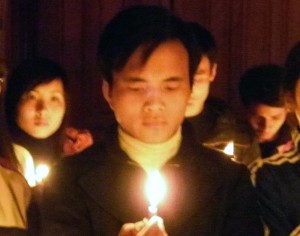
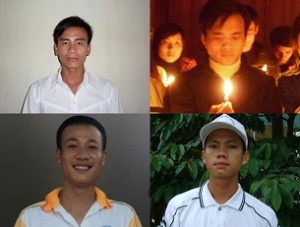
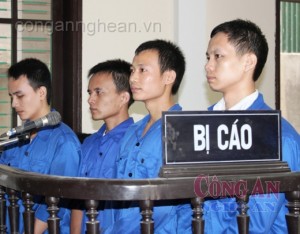

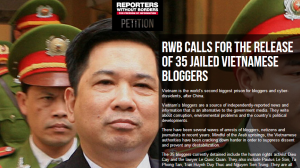
October 2, 2014
Lien Tri Pagoda – A Victim of the All-Out Effort to Suppress Religious Freedom in Vietnam by the Communist Party of Vietnam (CPV)
by Nhan Quyen • Thich Khong Tanh
Defend The Defenders | Oct 1, 2014
Translation by [rollinglinks]Huynh Thuc Vy [/rollinglinks]
Tell the World
The Government of Vietnam (GVN) in Hanoi recently renews its campaign to suppress human rights and take down religious establishments not currently under its management. This campaign has received a great deal of attention – mostly extreme outrage and indignation – from the international community and also public opinion both inside and outside of the country.
A key target of the GVN in the above campaign is Lien Tri Pagoda. The GVN is attempting to take down this religious establishment using technique called “implementation of administrative coercive measures.” In this technique, the GVN in Hanoi makes the lowest level local government collect the information needed to prosecute the targeted establishment while being monitored by international organizations. Through this technique, the GVN hopes to minimize the adverse risk that during negotiations or discussions with the GVN, Western officials will accuse it of oppressing religious groups or committing human rights violations to strengthen their bargaining position.
This short article reports on the current status of Lien Tri Pagoda and aims to inform and alert public opinion about current and flagrant violations of human rights and religious freedom perpetrated by the GVN.
Lien Tri Pagoda is located on Thu Thiem peninsula at 153 Luong Dinh Cua Street, District 2, Saigon. The Thu Thiem peninsula is a quasi-circular area about 7 square kilometers in area (1,726 acres). The peninsula is carved from the banks of the Saigon River as it meanders its way to the South China Sea. From the air, one can see that the southern tip of the peninsula points to the center of the city. Due to its location, the Thu Thiem peninsula has been selected to be site of an ultra-modern and ambitious upscale housing and financial center development project dubbed the New Thu Thiem Urban Area. For this project to become a reality, lots of people will have to be displaced, and home and established building razed.The photos below show the location of Lien Tri Pagoda and a conceptual view of the future New Thu Thiem Urban Area.
Lien Tri Pagoda was built around the 1956-1957 timeframe thanks to the contributions from local Buddhists. The 800 square meters (8,611 square feet) pagoda was originally dedicated to Venerable Thich Thien Hoa, the late Abbot of the Institute for The Propagation of The Faith of the United Buddhist Church of Vietnam. The abbot of Lien Tri Pagoda since 1969 has been Venerable Thich Khong Tanh.
“When I took over the pagoda,” Venerable Khong Tanh likes to confide: “it was a just small temple, probably no bigger than a village shrine. Later, thanks to the contributions from the Buddhists, we were able to expand it a little to make it more spacious. After 1975, I had plans to renovate the main hall, fix up the statue of the Buddha to make it more dignified, and add rooms for members of the Sangha (Buddhist clergy). However, the government opposed these plans, and issued numerous administrative citations to the pagoda for illegal constructions.”
After 1975, the Government of Vietnam (GVN) implemented a policy aimed at corrupting and eliminating Buddhism in South Vietnam. Directed by the GVN, the Board of Governors of the City Buddhist Association – a puppet religious organization established and run by members of the Communist Party of Vietnam (CPV) – issued a document that “officially” stripped Lien Tri Pagoda’s of its legal right to exist and Venerable Thich Khong Tanh of his rights to be a monk.
Some additional details about Venerable Thich Khong Tanh are pertinent here. Born Phan Ngoc An, the Venerable is an ordained monk, a member of the Sangha of the United Buddhist Church of Viet Nam (UBCVN), and a courageous individual who spent most of the years between the fall of Saigon in 1975 through 2000 in communist prisons. Specifically:
He returned to live at Lien Tri Pagoda after his release from jail in 2000. There he has remained active in demanding religious freedom and human rights for Vietnam.
This rare and true practitioner of his religion spent years in prison fighting for his faith and the country. Yet, the GVN has never given up on its plans to suppress him or to destroy his reputation. One of the dirty tricks the GVN used was to order female members of the Public Security Forces to try to seduce and smear him. Of course this trick backfired and caused great indignations and outrages in the Buddhist communities as well as in many other groups in the general population.
Because of his work in building up and propagating the faith he believes in, Venerable Thich Khong Tanh has become a threat and a significant thorn on the side of the CPV and its plan to eradicate all religions in Vietnam in general and Buddhism in particular.
On September 3, 2014, the Chairman of the People’s Committee of District 2, HCM City, Mr. Nguyen Cu, signed a Decision to “approve the plan to compensate and support the Lien Tri Worship Establishment in the Thu Thien planned city development zone”.
The Decision provides a 5.4 billion VN Dong (USD 275,000) compensation for Lien Tri Pagoda. However, the Decision doesn’t contain provisions for additional compensation needed to fund the costs of moving, rebuilding and re-establishing the pagoda and its operations elsewhere. The lack of such provisions is an irregularity that will make it impossible to rebuild the pagoda and thus deprive the monks of an important facility where they could resettle to restart their operations.
It might be worth mentioning here that close to 15,000 people reside on Thu Thiem peninsula. Of these, 11,000 have submitted petitions protesting the illegal and coercive orders that deprived them of the land on which their houses were built. To force people out of their homes without any provisions for relocating them is totally against all existing regulations.
The Migration Order was signed by the Chairman of the People’s Committee of District 2. It will be given to the following organizations: the head of the office of the District People’s Committee, and the Chair of the Compensation Committee, and the various departments at the district and local levels. These departments will be responsible for monitoring and implementing the order.
Additionally, the government order to reclaim the land reserved for burials and worships around and owned by Lien Tri Pagoda contains an Appendix with clauses that are of a coercive nature.
When discussing the situation of Lien Tri Pagoda with Venerable Thich Khong Tanh, we learned that as the abbot of Lien Tri pagoda, he has sent protest letters to the People’s Committee of the District and the People’s Committee of the City asking them to rescind the reclamation order. He also asserted: “We will absolutely not accept any compensation. If the Government of Vietnam wishes to close the book on this and destroy the religious establishment that Lien Tri Pagoda is, do send us the Coercion Order as stipulated by current laws so that the religious establishments could communicate and support each other and pray…What I am most concerned about what will happen after the state has razed the Pagoda and leveled the site. Where will the statue of the Lord Buddha, the sacred cremation jars, and the hundreds of commemorative tablets for the souls of the deceased go now?”
At the present time, the city government hasn’t issued an official reply to the letters of protest that Venerable Thich Khong Tanh submitted. In an Appendix of the Notice from the Compensation Commission, the government will initiate coercive steps to take back the land on which Lien Tri Pagoda stands.
We are very and truly concerned that the local government is firmly committed to removing Lien Tri Pagoda. The pagoda is where civil society organizations hold many of their meetings. It is also the location where Venerable Thich Khong Tanh holds his recognition and gift-giving sessions for disabled veterans of the Republic of Vietnam and distributes offerings to people suffering from cancers and tumors. It is also the place where many of the wrongly accused people who lost their land and home have found refuge and solace.
Currently, only three religious establishments, the Congregation of the Lovers of the Holy Cross (Est. 1840), Thu Thiem Catholic Church (Est. 1860), and Lien Tri Pagoda (Est. 1944) haven’t been affected by the reclamation order.
Religious organizations, civil society organizations, and Buddhists inside and outside of the country have reacted strongly against the government’s decision to take back the land on which Lien Tri Pagoda stands.
Inside the country, the Interfaith Council of Vietnam, which includes dignitaries from the five major faiths of Vietnam – Buddhism, Catholicism, Protestantism, Hoa Hao and Cao Dai – have issued a Joint Declaration to protest the government’s decision to take down Lien Tri Pagoda. The declaration made clear that such a decision is anti-constitutional.
Numerous efforts to collect signatures pledging support for Lien Tri Pagoda have been initiated. These efforts are gathering strength.
The photos of Lien Tri Pagoda that we see now are probably the last ones we will ever see of it. Comes September 30, and the place where Lien Tri Pagoda used to be will become an uneven, empty and dilapidated dirt lot. Open your mind’s eyes and you would see strewn everywhere on the lot broken pieces from statues of the Lord Buddha and shards from smashed cremation jars. Look harder and you might yet see among the swirling dirt devils forlorn and ashen ghosts straggling around searching for another eternal resting place. No bells will toll for these souls. The bells of Lien Tri Pagoda would have been silenced forever. And if you listen long and hard enough with your mind’s ears, you might yet hear the hellish cacophony that scientific dialectic materialism, the belief in the primacy of materialism over consciousness, and the never ending, greedy and merciless struggles for money and power conspire to bring forth.
After Lien Tri Pagoda, which religious establishment will be next?
Huynh Trong Hieu
Saigon, September 26, 2014